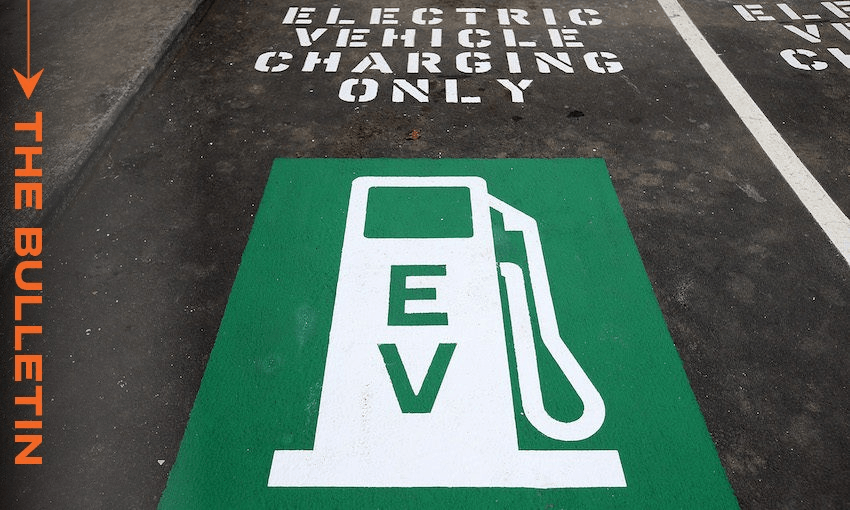In this extract from today’s edition of The Bulletin by Stewart Sowman-Lund, what the watering down of clean car import standards means. To receive The Bulletin in full each weekday, sign up here.
A softened approach
Earlier in the week, the government announced it was changing the rules on fuel efficiency for car imports, a move described by RNZ as a watering down of the standards. The new standards will bring us in line with Australia, with the transport minister Simeon Brown describing the two countries as effectively a single market. The clean car standard imposed penalties on the import of certain gas guzzling vehicles and were introduced in an effort to improve the uptake of lower-emitting vehicles, explained George Driver for The Spinoff in 2021. But Brown reckons they made it harder for importers and resulted in car buyers suffering higher upfront costs. Stuff has the updated standards, noting that they will mean certain utes are exempt. As petrol prices creep back up again – more on that below – some are worried that New Zealanders will find it harder and more expensive to buy electric vehicles, and the environment will suffer as a result. So today, a look at the state of the EV market in New Zealand, and whether enough is being done to keep us on the right track.
What could this mean for our EV fleet?
It’s worth noting that the clean car standard is distinct from the already scrapped clean car discount which incentivised buyers to purchase green(er) vehicles. Newsroom’s Marc Daalder reported that the decision to end that scheme resulted in a dramatic drop in electric vehicle sales. Scrapping the rebate was a clear signpost of the government’s intentions for the clean car standards, which cover retailers rather than customers. Both the Motor Industry Association (MIA) and Imported Motor Vehicle Industry Association (VIA) have been vocal about their dislike for the clean car rules, and AutoTalk reports that the MIA “worked extensively with officials to review the standard”.
But lobbying works both ways, and those representing the electric vehicle industry are unsurprisingly unhappy with the latest moves. Drive Electric’s Kirstin Corson told Newstalk ZB’s Ryan Bridge that Australia still has federal and state incentives in place, meaning it remains more attractive to buy an EV across the ditch. That same group released a report last year forecasting that removing clean car policies could see 350,000 fewer EVs on our roads by the end of the decade. Bernard Hickey noted in The Kākā that while Brown might claim he’s creating an equal market with Australia, that country applies tougher penalties on importers for missing their emission targets than we will here under the new rules.
How are we tracking on EV uptake?
In July 2023, wrote Jestin Lester for The Spinoff, 55% of New Zealand new vehicle registrations were low emission, overtaking fossil fuel registrations for the first time in NZ’s history. That trend continued into the latter part of the year, with Lester arguing it showed a “paradigm shift” was taking place in New Zealand. Of course, the aforementioned report by Marc Daalder appears to show that trend has been halted and a follow-up report in May showed the worst quarter sales for new EVs in nearly three years. But are there any moves taking place to try and stem the flow of people back to petrol?
During the election campaign, National promised it would roll out 10,000 new electric vehicle chargers up and down the country at a cost of $257m. There were concerns in June this year, 1News’ Jacob Johnson reported, that the lofty promise could turn out to be “National’s KiwiBuild”, according to an EV advocate. And this week, RNZ’s Eloise Gibson reported that New Zealand was at the bottom of the league table for EV chargers. As of April, Gibson said, we had 1,200 public EV chargers, meaning 130 new ones will be needed every month to meet the 2030 goal. But to justify chargers, you need cars first – an issue that the clean car discount was meant to help address. The government has argued that EV prices are falling and a subsidy was no longer needed to incentivise uptake. Drive Electric’s Kirsten Corson told Newsroom that’s true in part, but we’re still a long way off reaching price parity with petrol vehicles.
A ‘flimsy’ climate strategy
In the same week the clean car standard was watered down, the government unveiled its new climate strategy. The three-page document was light on policy, instead focussing on five core pillars that the government said underscored its “commitment to delivering on our climate change goals”. The Greens labelled the strategy a “pamphlet”, however, while Labour’s Megan Woods said it was “flimsy and backwards looking”. Meanwhile, this morning, the government has announced it wants to tackle “excessive use” of road cones and temporary speed restrictions on our roads, reports Thomas Coughlan at the Herald.
I promised we’d swing back to petrol prices to finish. Stuff’s Brianna McIlraith took a look at this last month, talking to AA’s Terry Collins who noted that fuel prices appeared to be following the same trend as last year: rising, falling and then rising again. The good news is they should ease back again by the end of the year. But don’t expect petrol to be cheap ever again.


